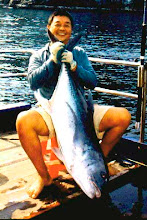Lately I have been spending a lot
of time in Taiping on some family errands. Like ants attracted to sugar, we
anglers somehow will gravitate to some tackle shops whenever we have some time
to kill. The shops that I normally hang around was none other than Syarikat
Weng Hwa, which belongs to my friend Chong Peng Kuan.
Being the “thick skin” fellow
that I am, I began to ask, beg and threaten for secret fishing spots from the anglers
that came to the shop. Maybe he was scared that I would drive away all his
customers, Peng Kwan introduced me to Tan. When Tan told me they have been
catching tilapias with bare treble hooks, I was not impressed. In fact, I was
quite contemptuous of all foul-hooking methods. Sensing my disdain, Tan immediately
added their method was above board. All the tilapias were hooked in their
mouths! Don’t tell me that they were using lures, I thought to myself.
Immediately my attitude changed from
that of disinterest to that of an inquisitive angler. Instead of explaining to
me the method of fishing, Tan gave me the direction to the pond where he and
his gang normally fish with fantastic results.
 |
| This was one of the sheds built over the edge of the pond. |
Luckily I was not booked by any traffic
police for speeding, for I think I drove quite fast to that pond. Situated near
Taman Kaya, this pond was fed by a tiny stream. Following the direction given to
me by Tan, I headed to two sheds built over the water edge. Here, a number of
anglers were already waiting patiently with rods in their hands. A few of them
were seen leaving, struggling under the weight of their catches. I regretted that
I did not bring my camera along.
While here, I was made to feel at
home by all the friendly anglers. Their comradeship was very infectious. A seat
was immediately vacated for me (Actually one must possess some good “jacking”
skill). Making myself comfortable, I began to observe those friendly anglers in
action.
Their method of fishing, in fact
was very innovative. It took advantage of the unique characteristic of the cichlid
family….that is their obsessive habit of keeping their nests clean.
 |
| A piece of strip lead was attached to the shank of the treble hook to add weight to it. |
The tackle used was just rods,
reels and lines or telescopic rods and lines with tiny treble hooks attached.
The tiny trebles had tiny pieces of strip lead attached to add weight to the
hooks. Above the trebles were attached small sliding floats. The distance of
the sliding floats to the trebles were adjusted so that the floats would just
be floating on the surface of the water when the trebles were resting on the
bottom of the pond.
The hooks were lifted up a few
centimeters occasionally and then allowed to drop on another spot. This
procedure was repeated until the float sank below the surface of the water.
They were then allowed to rest there for a few minutes, as the hooks should
have dropped into the depressions of the tilapias’ nests.
 |
| A piece of colorful cloth was sometimes tied to the hook to make the 'debris' more attractive. |
Yes, the tilapias always dig
depressions into the sandy bottom of the pond as their nests. They then proceed
to clean their nests of any debris so as to impress any prospective mates. This
obsessive cleaning habit was fully taken advantage of by the anglers.
If there was a fish guarding the
nest, sooner or later it would pick up the hook and deposit it some distance away.
The moment the float pooped up to the surface or moves, the angler would strike,
thus hooking the tilapia in its mouth. All fish caught this way were lip
hooked. Some anglers would decorate their trebles with tiny pieces of colorful
cloth to enhance the “piece of debris’, I presume.
 |
| Wong proudly displayed his very presentable catches. |
Needless to say, my camera was by
my side the next time I sojourned to the pond. A few of them were kind enough to
pose for me with their catches. I found out too, that the sheds that were built
over hanging the water were done the ‘gotong royong’ way.
One peculiar thing was the tilapias were normally caught around noon to 2.00pm. After 3.00pm the catches would taper off. According to the locals, the fish would have moved to the middle or the deeper part of the pond towards evening as the cast net kakis would come in droves after that time.
 |
| Not to be outdone, En. Mohd Azlan too held up his trophy. |
One peculiar thing was the tilapias were normally caught around noon to 2.00pm. After 3.00pm the catches would taper off. According to the locals, the fish would have moved to the middle or the deeper part of the pond towards evening as the cast net kakis would come in droves after that time.
The water condition too must be
right for a good catch. If it is too muddy, the fishing could not see the hook
and the ‘debris’. If it is too clear, the fish could see the hook and line clearly
and would shy away.
Some purists might condemn this
method of fishing. In my opinion, it could be considered as legitimate. After
all, lure fishing take advantage of the aggressive nature of certain fish to
protect their youngs or territories. Some were caught because the lures looked
like some familiar food. Thus fooling the fish to pick up the hook is also the
same.
To me, as long as it does not
involve wild casting and wild jerking with trebles, it is ok with me. Well, I
will leave it to the anglers to make their own judgment.













